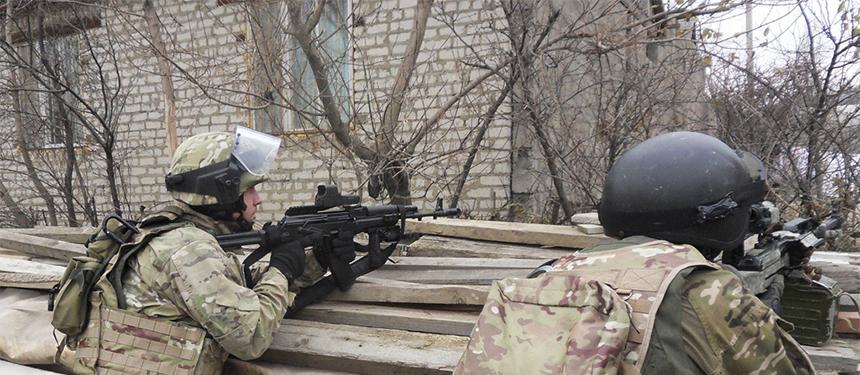Ramzan Kadyrov claims the Chechen insurgency is over. Is it?

We explore the background of the North Caucasus insurgency and why Kadyrov’s proclamation of victory is likely to be premature.
On 20th January, Russian Special Forces conducted an operation that killed six militants affiliated with Islamic State – Caucasus Province (ISIL-CP). The assault took place in the village of Katyr-Yurt, roughly 1,500 km south of Moscow in Chechnya, one of the largest regions which together comprise Russia’s North Caucasus territory.
Among those killed was Aslan Byutukayev, an insurgent commander who is believed to have played a major role in the bombing of Moscow’s Domodevevo Airport in 2011, which killed 37 people and wounded 173 more. Byutukayev was also implicated in a number of bombings in Chechnya’s regional capital, Grozny. Chechnya’s notorious strongman governor – Ramzan Kadyrov – claimed the operation marked the elimination of what remained of a once-potent Chechen insurgency.
The Chechen Insurgency
The Republic of Chechnya is part of Russia’s North Caucasus region in Russia’s south-west, close to its borders with Georgia and Azerbaijan. The territory has experienced over two decades of fighting between Russian military forces and a complex insurgency, made up of both radical Islamist elements that aim to establish an independent Islamic emirate and less Islamist separatist segments, which simply desire more autonomy from the federal government. Chechnya originally attempted to declare independence from the Soviet Union in 1991, much like Ukraine, Kazakhstan and other constituent republics. However, amid Russian fears that Chechnya’s possible secession would trigger a domino effect of the other republics in the country, the then-president Boris Yeltsin sent troops into Chechnya, to – as he saw it – restore order.
Two major wars were fought between the Russian military and Chechen insurgents; the first took place between 1994 and 1996, and the second took place between 1999 and 2009. The wars together claimed at least 150,000 lives. From 2009 onwards, Islamist militants in Chechnya have been waging a low-level insurgency against the Russian government and have been responsible for a number of high-profile terrorist attacks, including the 2010 Moscow Metro bombing, the 2011 Moscow Domodedovo International Airport (DME) bombing, the October and December 2013 suicide bombings in Volgograd, the 2014 Grozny bombing and the 2017 Saint Petersburg Metro bombing.
How has the Russian government attempted to combat the Chechen insurgency?
Since the end of major combat operations in 2009, the Russian military has continued to mount effective counter-insurgency operations. In contrast to the ‘hearts and minds’ approach preferred by most Western militaries, the Russian military has often deployed overwhelming force, giving short shrift to the human rights and legal constraints that have typically constrained Western militaries. Senior members of the insurgency are frequently killed, weakening central command and control structures, undermining organisational resilience and forcing insurgents into smaller, often poorly organised and less capable cells. Dissidents abroad are also frequently assassinated. The successors to these leaders are frequently less experienced and respected than their predecessors, undermining the insurgency’s ability to recover from this relentless tempo of targeted killings. This ruthless approach has frequently resulted in accusations of human rights violations but has been highly effective.
Russia has also benefited from an outflow of insurgents to join jihadist groups in Iraq and Syria in recent years, as these conflicts appear more ‘glamorous’ for would-be jihadists. A significant proportion of these are believed to have died in the Middle East and the government has largely been effective in managing returning foreign fighters. The rise of Iraq and Syria as alternative theatres of conflict also exposed a major fracture within the insurgency, with the divide between those who believed the insurgency should constitute a regional arm of a global jihadist movement, and those who saw it as an independent separatist movement becoming increasingly unbridgeable. This has resulted in large segments of insurgency becoming disorganised and divergent.
Mission accomplished?
Kadyrov’s declaration of victory is likely to be premature. While the Chechen insurgency is undoubtedly not what it once was, insurgents have still mounted a number of small-scale attacks and Russian military operations continue to take place, suggesting a continued insurgent threat. One soldier was killed in a stabbing in Chechnya’s capital of Grozny on 1st January and another three militants were killed by the Russian security forces in two separate incidents throughout December 2020. The Russian security services also prevented at least 41 terror attacks throughout 2020, suggesting a significant intent to carry out attacks, if not the capability of old.
To speak of the end of the threat also discounts the underlying conditions that have underpinned the durability of the insurgency until now. Chechnya remains a deeply disenfranchised region; regional governors are largely viewed as proxies of the federal government, while unrest remains comparatively frequent. Corruption is rife and ethnic Chechens continue to face widespread discrimination at all levels of Russian society. It also remains one of Russia’s poorest regions, with over 50% of Chechens living on less than $1.10 a day and 13.5% of its population living below the poverty line. Another issue to consider is the demographics of the region. Chechnya has a high fertility rate and low median age relative to Russian national averages and the concern is that the generation which fought two large-scale wars against the Russians will gradually be replaced by a younger cohort who have grown up against a backdrop of disenfranchisement, religious radicalism and persistent violations of human rights.
Ironically, the government’s approach – which has up to this point inflicted significant damage on the insurgency – may end up perpetuating it over the longer-term by strengthening its support base and confirming insurgent narratives of injustice towards ethnic Chechens, particularly among younger groups.The Chechen insurgency may be down, but not out, with continued potential to mount attacks in both the North Caucasus and Russia in the coming months. A true ‘victory’ will require far more than just force.




